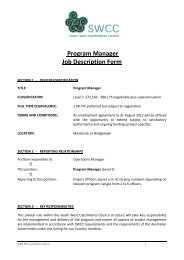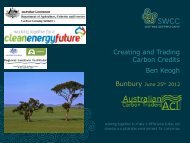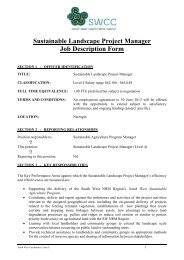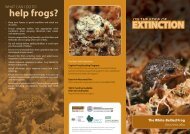Tender for the Programme - South West Catchments Council
Tender for the Programme - South West Catchments Council
Tender for the Programme - South West Catchments Council
Create successful ePaper yourself
Turn your PDF publications into a flip-book with our unique Google optimized e-Paper software.
DRAFT<br />
<strong>South</strong> <strong>West</strong> Regional NRM Strategy – Ancillary Document<br />
This document presents <strong>the</strong> System Documentation and User Guide <strong>for</strong> <strong>the</strong> <strong>South</strong> <strong>West</strong> <strong>Catchments</strong> <strong>Council</strong> (SWCC)<br />
Investment Decision Support System (a key component of <strong>the</strong> Waterway Health Sub-Strategy and Biodiversity Sub-Strategy.<br />
As such, it has no specifically useful in<strong>for</strong>mation, but is needed when consulting <strong>the</strong> sub-strategies.<br />
State NRM Office 2007 Agency Statement of important Natural Resource Management Assets in<br />
<strong>West</strong>ern Australia. Unpublished Report prepared <strong>for</strong> NRM Senior Officers Group, Government of<br />
<strong>West</strong>ern Australia. 107 pp.<br />
Key document that states <strong>the</strong> State Government’s position on NRM assets of WA. The report presents <strong>the</strong> views of each<br />
Department on <strong>the</strong> respective NRM assets <strong>for</strong> which it has primary responsibility. A limitation is that <strong>the</strong> report presents differing<br />
levels of detail on in<strong>for</strong>mation and <strong>the</strong>re<strong>for</strong>e comparisons between asset classes are not recommended without fur<strong>the</strong>r<br />
in<strong>for</strong>mation from each section’s respective authors. It focuses primarily on biophysical or tangible assets and has not addressed<br />
<strong>the</strong> social and socio-economic asset class. Highest priority assets included: 6 IBRA sub bioregions, 6 marine conservation<br />
reserve regions, 2 terrestrial IBRA subregions, 7 marine conservation reserves, 343 flora species (terrestrial), 58 fauna species<br />
(terrestrial), 54 TECs (terrestrial), 5 marine fauna species, 24 proposed and existing natural diversity recovery catchments, 7<br />
target landscapes, 13 IBRA provinces with species hotspots, 62 water supplies and 34 waterscapes, 5 aquatic assets and 1<br />
soil-landscape zone (See also <strong>the</strong> secondary document DoE 2003).<br />
Steele, J.J. 2006 Management of diffuse water quality issues in <strong>the</strong> Peel-Harvey coastal drainage<br />
system – A literature review.<br />
The review considers Best Management Practice options <strong>for</strong> water quality improvement along watercourses in a <strong>for</strong>mat relevant<br />
to <strong>the</strong> Peel-Harvey catchment. The drainage system is a highly degraded and modified system where works along drainage<br />
lines need to be prioritized due to limited funding, where institutional change in drainage management practices is needed and<br />
where <strong>the</strong> downstream receiving water bodies are of international ecological significance. The need <strong>for</strong> drainage maintenance<br />
in <strong>the</strong> Peel-Harvey catchment has not been disputed in this review. What has been disputed is <strong>the</strong> method in which <strong>the</strong>se works<br />
are scheduled and implemented. Recommendations include <strong>the</strong> need to determine <strong>the</strong> conveyance requirements of waterways<br />
so that stable, vegetated drains with adequate drainage capacity can be able to be designed and implemented.<br />
Stuart-Street, A 2003 Natural resource management issues in <strong>the</strong> agricultural zone of <strong>West</strong>ern Australia<br />
– <strong>South</strong> <strong>West</strong> Region. Department of Agriculture, Government of <strong>West</strong>ern Australia, Perth, WA. 56<br />
pp.<br />
The document provides an analysis of current pressures on agricultural resources of <strong>the</strong> SW Region. Data were not presented<br />
on <strong>the</strong> actual areas of land affected by <strong>the</strong> various <strong>for</strong>ms of degradation as <strong>the</strong>se weren’t <strong>the</strong>n available and regional land<br />
resource surveys were interpreted to estimate <strong>the</strong>se areas. These estimations are based on characteristics of <strong>the</strong> soils and<br />
landscapes within <strong>the</strong> region. Differing ranges of risk are shown <strong>for</strong> different issues because of varying impacts. Each natural<br />
resource management issue is covered in four sections: 1) Extent; 2) Impacts; 3) Management options; and 4) Effectiveness.<br />
SWCC 2005 <strong>South</strong> <strong>West</strong> Regional Strategy <strong>for</strong> Natural Resource Management. <strong>South</strong> <strong>West</strong><br />
<strong>Catchments</strong> <strong>Council</strong>, Bunbury, 164 pp. + CD<br />
Previous strategy and a key document guiding <strong>the</strong> development of <strong>the</strong> strategy.<br />
SWCC 2010 Community Engagement Strategy – Planning <strong>for</strong> 2010 and Beyond (v.7). Prepared by <strong>the</strong><br />
Community Engagement Team, SWCC <strong>for</strong> <strong>the</strong> <strong>South</strong> <strong>West</strong> <strong>Catchments</strong> <strong>Council</strong>, Bunbury, WA. 59pp.<br />
Title describes content. The community engagement strategy has been developed to assist SWCC to undertake community<br />
engagement <strong>for</strong> improved Natural Resource Management (NRM) outcomes and strategic organisational development, now and<br />
into <strong>the</strong> future. The strategy has two main <strong>the</strong>mes:<br />
SWCC’s overarching engagement approach – i.e. guiding principles <strong>for</strong> how SWCC as an organisation works with-its<br />
stakeholders and a long-term objective <strong>for</strong> how to achieve this; and<br />
SWCC’s operational approach – i.e. practical in<strong>for</strong>mation <strong>for</strong> SWCC staff to ensure that <strong>the</strong>y are using <strong>the</strong> most effective and<br />
appropriate tools to engage <strong>the</strong>ir relevant stakeholder groups.<br />
Syrinx Environmental PL 2008 Scott Coastal Plain – Best Management Practices. Prepared <strong>for</strong> <strong>the</strong><br />
BBG by Syrinx Environmental PL, Perth, WA. 103 pp.<br />
This report is intended to provide technical in<strong>for</strong>mation to landholders and o<strong>the</strong>rs on <strong>the</strong> best available means of minimising <strong>the</strong><br />
environmental impacts of on-farm activities on <strong>the</strong> Scott Coastal Plain. The report broadly outlines <strong>the</strong> background in<strong>for</strong>mation<br />
on <strong>the</strong> selected best management practices and is accompanied by a self-assessment checklist. Landholders using <strong>the</strong><br />
checklist will be able to undertake an initial self-assessment to create a personal benchmark <strong>for</strong> <strong>the</strong>ir own environmental<br />
per<strong>for</strong>mance and while undertaking this process determine where improvements would be beneficial. The Best Management<br />
Practices (BMP’s) included in this document are applicable across a wide range of agricultural industries to improve<br />
environmental management and include Environmental Best Practice measures <strong>for</strong> water management, irrigation management,<br />
drain management, nutrient management; soil management; effluent management, and timber plantation management.<br />
Unmack, P 2011 Freshwater ecoregions of <strong>the</strong> world – 801: <strong>South</strong>western Australia. Accessed on Dec<br />
04 2011 on: http://www.feow.org/ecoregion_details.phpeco=801<br />
Description of <strong>the</strong> freshwater habitats and its fauna in SW Australia.<br />
17






